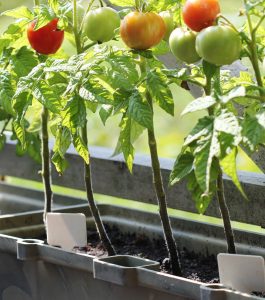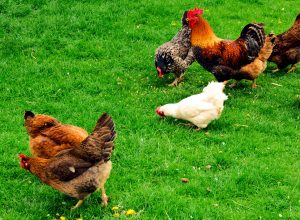How Much Land do you Need to be Self-Sufficient?

With a world food crisis, drought and civil unrest over escalating food prices, around the world, we all have concerns about food security and the ability to feed our own families. An info-graphic is circulating the internet that tells us that we need a full 2 acres to be self-sufficient in food on an omnivore diet, implying less land if one is vegan. The problem with a graphic like this is that it discourages experimentation, and assumes a one-size-fits-all family eating style. It uses yield estimates taken from mono-cultural commercial agriculture and imposes them on the homestead. This discourages people who want to attempt to be self-sufficient and live a more sustainable life. 2 acres is a substantial investment in a highly productive agricultural belt or near an urban area. And this info-graphic assumes highly productive land — expensive land.
So is 2 acres a reasonable estimate? That depends on where you live and what you mean by “self-sufficiency”. When Canada was being divided up into homesteading grids — it was assumed that on the Prairies an average family would need a section of land (over 1,000 acres) to be self-sufficient. In those days, self-sufficient meant to survive to the next year, without grocery stores to fall back on. In Ontario and B.C. the amount of land necessary to feed and clothe a family was considered a 1/4 section — 160 acres. That area provided water, food, energy, and a livelihood. Along St. Laurence River and in the Maritimes the amount of land needed was less — due to the proximity of fishing and water. The closer one is to freshwater, whether a stream or through rainfall, the less land that is necessary to sustain a family.
Those in the North or at higher elevations need more land to be self-sufficient. It’s hard to grow food — other than livestock and hay — in a growing season that’s shortened by intermittent summer frost. But it can be done. Land in these areas is cheaper, too. You will need 5 to 15 acres to be productive in a Northern area and you will have more land dedicated to raising livestock and hay and less land dedicated to vegetables and fruit.
How much land do you need to be self-sufficient?
So what’s a reasonable estimate for how much land you really need to sustain your family?
Skip the 2,000 square foot house. It’s unnecessary. A smaller footprint that builds upward is a better use of space and is easier to heat and clean. Solar panels? Possibly if you are far enough south and have a good exposure. Wind? Micro-hydro? Methane? Wood? All are possibilities to explore for energy efficiency. Each property has to be assessed individually. There is no one-size-fits-all solution — except the grid. Cut the house footprint in half.
Livestock? Skip the pigs — they produce only meat and take up valuable space. Skip the corn unless you live in the South, where your summer has the heat value to ripen corn easily. The livestock doesn’t need it and it’s low on food value — 2 goats and 5 chickens can live on garden surplus, grass and weeds. 5 chickens will feed a family 2 dozen eggs a week in the peak laying season. They don’t need their own dedicated space. Put them in a movable chicken tractor and let them till the garden, eating bugs and weeds. Move them every morning during the growing season and it will improve your soil quality, too.
Goats can be housed in a shed near the house, a lean-to onto the house or even the back of the garage. They only need a small bedding area and can be taken for walks in the hedgerows of your neighbourhood to feed on browse. They can be given a loafing area or be tethered in different spots around the yard to help keep down weeds. Protect them from stray dogs and predators and they will give you 8 to 10 years of the highest quality raw milk for drinking, cheese, yogurt and ice cream. They can be fed with garden waste. Or share your field peas and produce with them, in exchange for their milk. Their manure will increase the fertility of the garden space. 2 full-size dairy goats will give your family a gallon of milk a day and 3 kids for 90 lbs. of meat every fall. Live in an urban area? Invest in Nigerian Dwarf goats and half the production rates, as well as the food inputs.
Instead of corn in cooler regions, grow potatoes. They offer more calories and can be grown in more climates and take up less space. You can follow a crop of potatoes with kale for a longer harvest season, even in a colder climate.
Don’t forget the orchard

Fruit and nut trees are a must. Nut trees take a while to mature but the increase in protein is beneficial to you, and your livestock — plant them if you have space. Dwarf fruit trees will grow on a 6-foot centre and can be trellised along a fence to increase yields per space. If space is at a premium, do consider trellising them — planting 6 feet apart in a one-foot wide row. One dwarf tree will yield 75 lbs. of fruit, once it is mature. 10 trees trellised along a fence with Southern exposure, blossom sooner in spring and have an extended growing season and will give you enough fruit for a family for jamming, canning and preserving.
Berries and small fruits take up little space and can offer high vitamins and antioxidants to your diet. If wild roses and wild strawberries grow in your area then other berries will as well.
Sunflowers are an annual crop that provides an increase in protein for your diet and can grow on the borders of the garden, taking up very little space.
Raised beds for vegetables

Vegetables, grown in raised beds or containers, give high yields and can be rotated for 3 season gardening — greens from spinach to lettuce to kale can rotate through the growing season to keep your plate full for daily salads and vegetables. We grow all the greens we need in about 20 square feet this way. Other vegetables, like cabbage, beans, carrots and beets, need a full growing season but can be inter-cropped with flowers and herbs to feed bees and provide medicinal plants for the family first aid kit. With raised bed gardening you could cut down the vegetable area square footage by 1/2 to 2/3rds Add a greenhouse and train vines to grow up instead of out and you can increase the growing season and the yields in the available space.
Community is essential
This chart fails to take into account the sharing that inevitably happens between gardeners — zucchinis, squash, lettuces and other prolific growers provide a bountiful harvest that many families can share, at the peak of the growing season.
Rabbits? Chickens? Ducks?
Put in some rabbit hutches – Each rabbit needs 2 feet by 3 ft. space. You can give them a grass run and build rabbit condos that offer them a wonderful, natural lifestyle. 3 female french angora rabbits and 1 male will provide your family with a meal of rabbit meat once a week and enough angora to keep your family in mittens and hats for the winter. They will eat your garden surplus and grass hay. In Europe, during WWII, families with backyard rabbits would make hay by harvesting the grass from vacant lots and roadsides all summer. And they make affectionate pets, too. Are we eating our pets? No, as a farmer you make pets out of the breeding animals and give the best possible life and respect to the young that end up on your plate.
You don’t need meat every day, but you do need high-quality protein every day and this kind of gardening will give you that.
Consider planting field peas for increased protein. Field peas increase the fertility of the soil and the crop is ready to harvest in August when the ground can be cleared and a second crop can be planted of either peas or winter vegetables. The straw from peas is relished by goats and rabbits.
Aquaponics
Consider the addition of an aquaponics greenhouse in the vegetable growing area. This will yield fish fertilizer, vegetables, and fish for a well-rounded diet for you and your garden — along with year-round vegetables. Add a methane digester and you can supply some of your own energy needs as well. If you can grow meat and vegetable year-round, you reduce your dependence on a freezer, which lowers your electrical needs.
My estimate is that in a highly productive area with adequate rainfall, the average family could raise all their food needs on 1 acre of land. Many did just this during WWII with just a large city lot, by walking their goats and moving their chickens around the vegetable garden. The key to making this work is to eat what you can grow in your climate — using heritage seeds that are adapted to your growing conditions. With more land — 5 acres — you can move from subsistence farming to commercial agriculture and begin to make some money from your productivity.
If you have more land, grow more food and expand your self-sufficiency. But if you only have a balcony in a city apartment, grow where you are planted. And start in a small way to be more self-sufficient now. On the Joybilee Farm Facebook Page, I post periodic links to urban agricultural projects to inspire your urban efforts for self-sufficiency.
One of my favourite resources for urban farms is the Urban Farm Guys. Their videos are practical step-by-step guidelines to help you harvest more food from a small amount of land.

Resources to help you be more self-sufficient
More resources for increasing vegetable yields in a small space:
Four-Season Harvest: Organic Vegetables from Your Home Garden All Year Long
The Winter Harvest Handbook: Year Round Vegetable Production Using Deep Organic Techniques and Unheated Greenhouses
All New Square Foot Gardening
Lasagna Gardening: A New Layering System for Bountiful Gardens: No Digging, No Tilling, No Weeding, No Kidding!






this is the dream!
1. Dreamed of it since I was young, maybe 15. Biggest influence was a frdeins father talking about it and TV shows, like Little House on the Prarie and Waltons.2.We grow a garden, getting close to enough for a year for two,and expanding. We raise poultry , chickens and turkeys , for meat and eggs, also rabbits. With our limited space of about 1.5 acres, they are most productive.3.Northeast TX, by Lake O Pines, because the opportunity to buy arose at the age of 19 with a family, I jumped on it and expanded as possible.4.Ceck water and condition of animals, gather eggs, work on garden, fence builings , whatever is needed, or outside of home, then make afternoon rounds to all animals again.5.Better to work for whats yours, than anothers. Although helping others is great to.6.Biggest problem in our enviroment is predators, coons, possum , skunk, coyotes, bobcats and dogs. We catch them when necessary and keep a good dog.7. We use a tiller, farmers almanac, water additives for vitamins, and wormers. Nothing that new.8.Both, good philisophical sense and spiritual good feeling.
You’ve hit the ball out the park! Inrcdielbe!